Leadership in Business: An Analysis of Fiedler's Contingency Model
VerifiedAdded on 2020/03/23
|5
|1124
|114
Essay
AI Summary
This essay provides a comprehensive analysis of Fiedler's Contingency Model, a prominent theory in leadership studies. It begins by outlining the core concepts of the model, including the Least Preferred Coworker (LPC) scale, leader-member relations, task structure, and positional power. The essay then critically evaluates the model, highlighting its strengths such as its well-defined parameters and research-backed framework, while also pointing out its weaknesses. The author argues against the model's subjectivity and narrow definitions, particularly concerning the LPC parameter and the simplification of situational factors. The essay emphasizes the limitations of the model's binary approach to task structure and leader-member relations, and the oversimplification of leadership power dynamics. The analysis concludes that while the model is well-researched, its practical application is limited due to its subjective parameters and oversimplified approach to real-world complexities in organizational leadership. The essay draws on several academic sources to support its arguments.
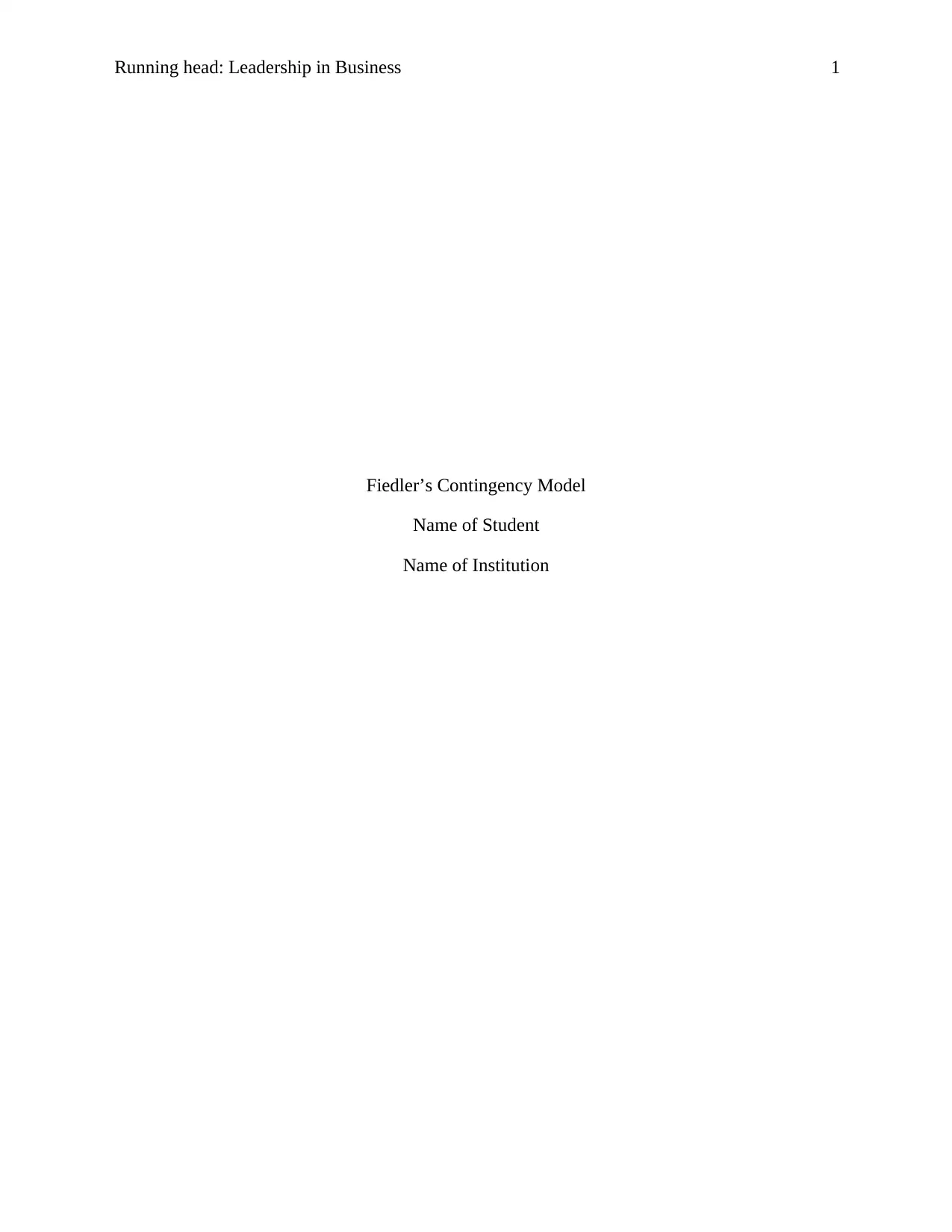
Running head: Leadership in Business 1
Fiedler’s Contingency Model
Name of Student
Name of Institution
Fiedler’s Contingency Model
Name of Student
Name of Institution
Paraphrase This Document
Need a fresh take? Get an instant paraphrase of this document with our AI Paraphraser
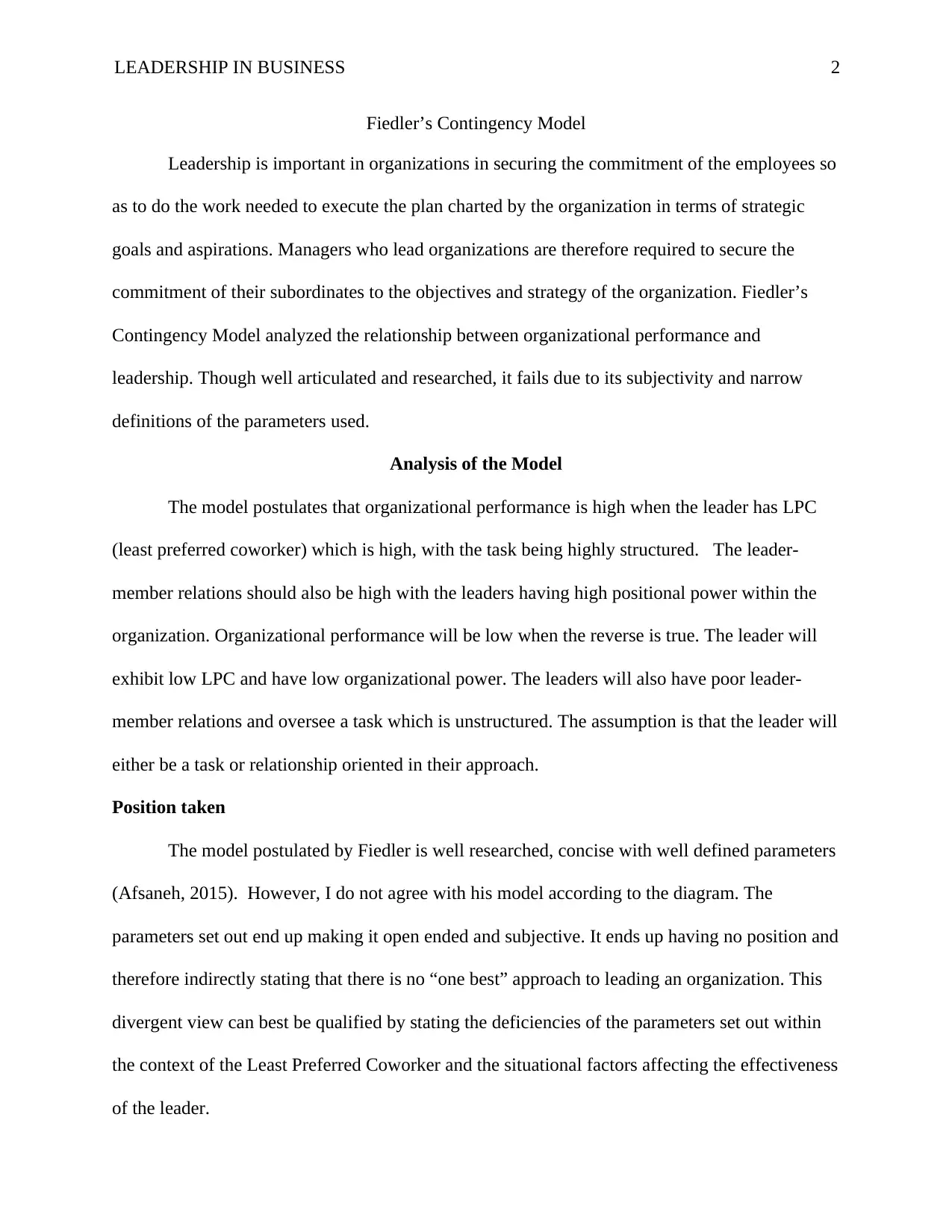
LEADERSHIP IN BUSINESS 2
Fiedler’s Contingency Model
Leadership is important in organizations in securing the commitment of the employees so
as to do the work needed to execute the plan charted by the organization in terms of strategic
goals and aspirations. Managers who lead organizations are therefore required to secure the
commitment of their subordinates to the objectives and strategy of the organization. Fiedler’s
Contingency Model analyzed the relationship between organizational performance and
leadership. Though well articulated and researched, it fails due to its subjectivity and narrow
definitions of the parameters used.
Analysis of the Model
The model postulates that organizational performance is high when the leader has LPC
(least preferred coworker) which is high, with the task being highly structured. The leader-
member relations should also be high with the leaders having high positional power within the
organization. Organizational performance will be low when the reverse is true. The leader will
exhibit low LPC and have low organizational power. The leaders will also have poor leader-
member relations and oversee a task which is unstructured. The assumption is that the leader will
either be a task or relationship oriented in their approach.
Position taken
The model postulated by Fiedler is well researched, concise with well defined parameters
(Afsaneh, 2015). However, I do not agree with his model according to the diagram. The
parameters set out end up making it open ended and subjective. It ends up having no position and
therefore indirectly stating that there is no “one best” approach to leading an organization. This
divergent view can best be qualified by stating the deficiencies of the parameters set out within
the context of the Least Preferred Coworker and the situational factors affecting the effectiveness
of the leader.
Fiedler’s Contingency Model
Leadership is important in organizations in securing the commitment of the employees so
as to do the work needed to execute the plan charted by the organization in terms of strategic
goals and aspirations. Managers who lead organizations are therefore required to secure the
commitment of their subordinates to the objectives and strategy of the organization. Fiedler’s
Contingency Model analyzed the relationship between organizational performance and
leadership. Though well articulated and researched, it fails due to its subjectivity and narrow
definitions of the parameters used.
Analysis of the Model
The model postulates that organizational performance is high when the leader has LPC
(least preferred coworker) which is high, with the task being highly structured. The leader-
member relations should also be high with the leaders having high positional power within the
organization. Organizational performance will be low when the reverse is true. The leader will
exhibit low LPC and have low organizational power. The leaders will also have poor leader-
member relations and oversee a task which is unstructured. The assumption is that the leader will
either be a task or relationship oriented in their approach.
Position taken
The model postulated by Fiedler is well researched, concise with well defined parameters
(Afsaneh, 2015). However, I do not agree with his model according to the diagram. The
parameters set out end up making it open ended and subjective. It ends up having no position and
therefore indirectly stating that there is no “one best” approach to leading an organization. This
divergent view can best be qualified by stating the deficiencies of the parameters set out within
the context of the Least Preferred Coworker and the situational factors affecting the effectiveness
of the leader.
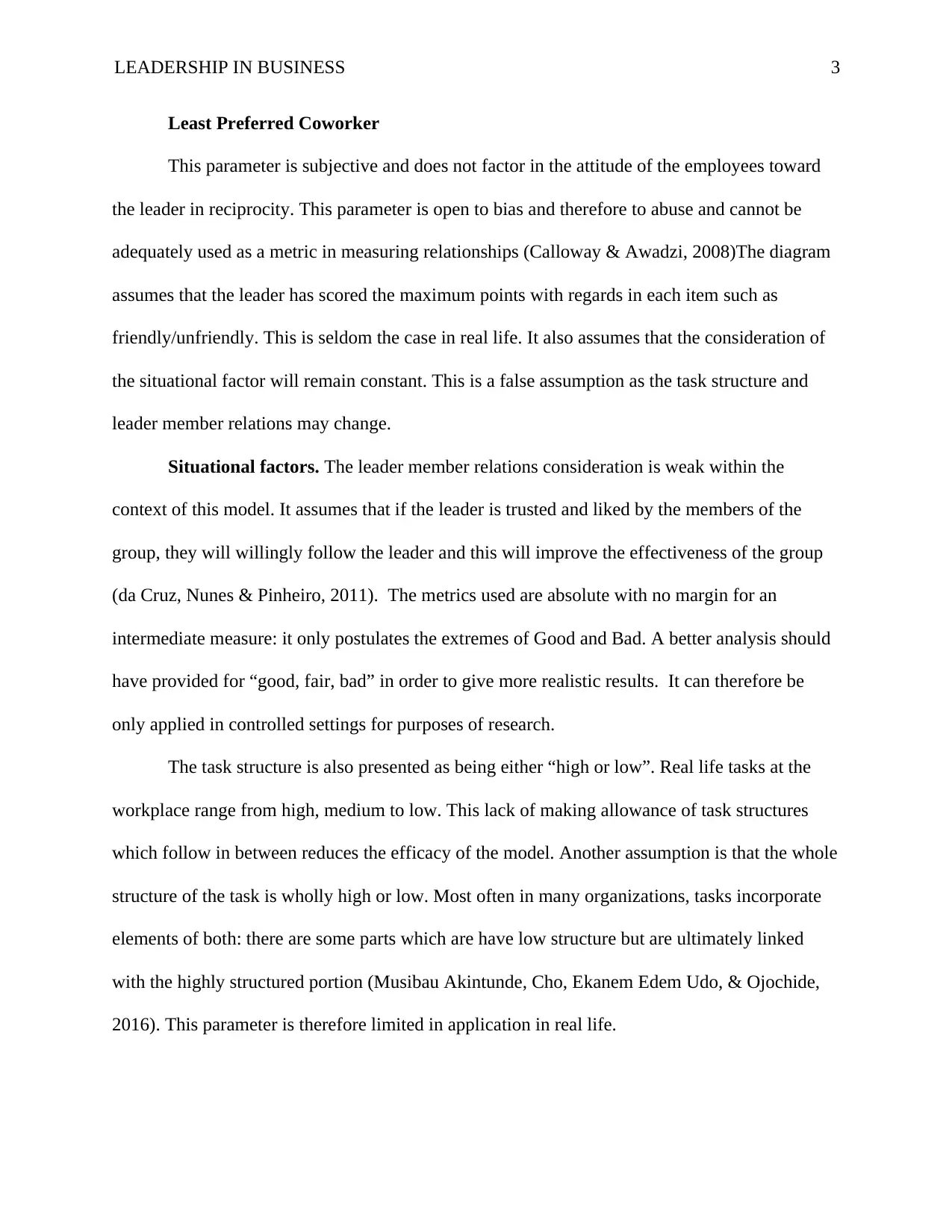
LEADERSHIP IN BUSINESS 3
Least Preferred Coworker
This parameter is subjective and does not factor in the attitude of the employees toward
the leader in reciprocity. This parameter is open to bias and therefore to abuse and cannot be
adequately used as a metric in measuring relationships (Calloway & Awadzi, 2008)The diagram
assumes that the leader has scored the maximum points with regards in each item such as
friendly/unfriendly. This is seldom the case in real life. It also assumes that the consideration of
the situational factor will remain constant. This is a false assumption as the task structure and
leader member relations may change.
Situational factors. The leader member relations consideration is weak within the
context of this model. It assumes that if the leader is trusted and liked by the members of the
group, they will willingly follow the leader and this will improve the effectiveness of the group
(da Cruz, Nunes & Pinheiro, 2011). The metrics used are absolute with no margin for an
intermediate measure: it only postulates the extremes of Good and Bad. A better analysis should
have provided for “good, fair, bad” in order to give more realistic results. It can therefore be
only applied in controlled settings for purposes of research.
The task structure is also presented as being either “high or low”. Real life tasks at the
workplace range from high, medium to low. This lack of making allowance of task structures
which follow in between reduces the efficacy of the model. Another assumption is that the whole
structure of the task is wholly high or low. Most often in many organizations, tasks incorporate
elements of both: there are some parts which are have low structure but are ultimately linked
with the highly structured portion (Musibau Akintunde, Cho, Ekanem Edem Udo, & Ojochide,
2016). This parameter is therefore limited in application in real life.
Least Preferred Coworker
This parameter is subjective and does not factor in the attitude of the employees toward
the leader in reciprocity. This parameter is open to bias and therefore to abuse and cannot be
adequately used as a metric in measuring relationships (Calloway & Awadzi, 2008)The diagram
assumes that the leader has scored the maximum points with regards in each item such as
friendly/unfriendly. This is seldom the case in real life. It also assumes that the consideration of
the situational factor will remain constant. This is a false assumption as the task structure and
leader member relations may change.
Situational factors. The leader member relations consideration is weak within the
context of this model. It assumes that if the leader is trusted and liked by the members of the
group, they will willingly follow the leader and this will improve the effectiveness of the group
(da Cruz, Nunes & Pinheiro, 2011). The metrics used are absolute with no margin for an
intermediate measure: it only postulates the extremes of Good and Bad. A better analysis should
have provided for “good, fair, bad” in order to give more realistic results. It can therefore be
only applied in controlled settings for purposes of research.
The task structure is also presented as being either “high or low”. Real life tasks at the
workplace range from high, medium to low. This lack of making allowance of task structures
which follow in between reduces the efficacy of the model. Another assumption is that the whole
structure of the task is wholly high or low. Most often in many organizations, tasks incorporate
elements of both: there are some parts which are have low structure but are ultimately linked
with the highly structured portion (Musibau Akintunde, Cho, Ekanem Edem Udo, & Ojochide,
2016). This parameter is therefore limited in application in real life.
⊘ This is a preview!⊘
Do you want full access?
Subscribe today to unlock all pages.

Trusted by 1+ million students worldwide
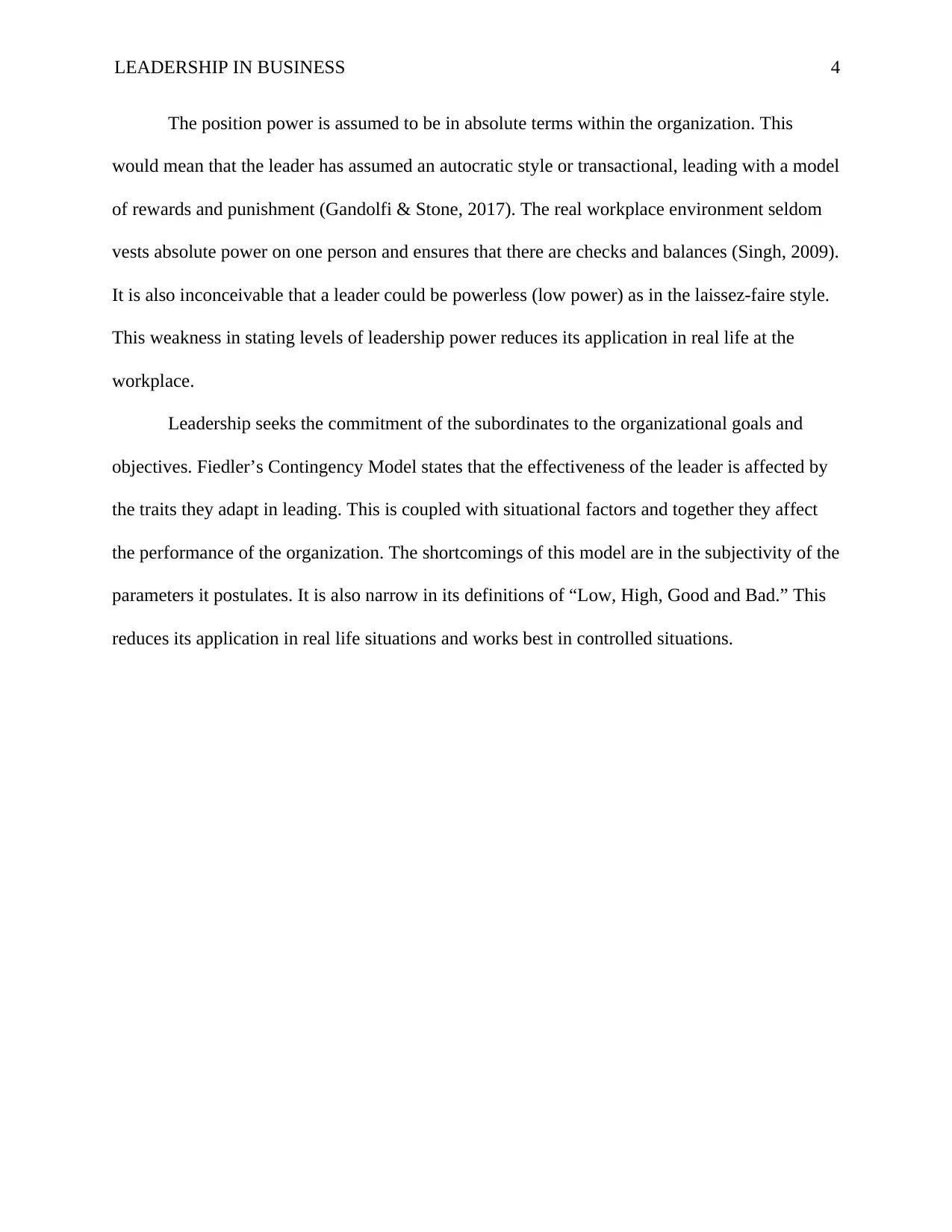
LEADERSHIP IN BUSINESS 4
The position power is assumed to be in absolute terms within the organization. This
would mean that the leader has assumed an autocratic style or transactional, leading with a model
of rewards and punishment (Gandolfi & Stone, 2017). The real workplace environment seldom
vests absolute power on one person and ensures that there are checks and balances (Singh, 2009).
It is also inconceivable that a leader could be powerless (low power) as in the laissez-faire style.
This weakness in stating levels of leadership power reduces its application in real life at the
workplace.
Leadership seeks the commitment of the subordinates to the organizational goals and
objectives. Fiedler’s Contingency Model states that the effectiveness of the leader is affected by
the traits they adapt in leading. This is coupled with situational factors and together they affect
the performance of the organization. The shortcomings of this model are in the subjectivity of the
parameters it postulates. It is also narrow in its definitions of “Low, High, Good and Bad.” This
reduces its application in real life situations and works best in controlled situations.
The position power is assumed to be in absolute terms within the organization. This
would mean that the leader has assumed an autocratic style or transactional, leading with a model
of rewards and punishment (Gandolfi & Stone, 2017). The real workplace environment seldom
vests absolute power on one person and ensures that there are checks and balances (Singh, 2009).
It is also inconceivable that a leader could be powerless (low power) as in the laissez-faire style.
This weakness in stating levels of leadership power reduces its application in real life at the
workplace.
Leadership seeks the commitment of the subordinates to the organizational goals and
objectives. Fiedler’s Contingency Model states that the effectiveness of the leader is affected by
the traits they adapt in leading. This is coupled with situational factors and together they affect
the performance of the organization. The shortcomings of this model are in the subjectivity of the
parameters it postulates. It is also narrow in its definitions of “Low, High, Good and Bad.” This
reduces its application in real life situations and works best in controlled situations.
Paraphrase This Document
Need a fresh take? Get an instant paraphrase of this document with our AI Paraphraser
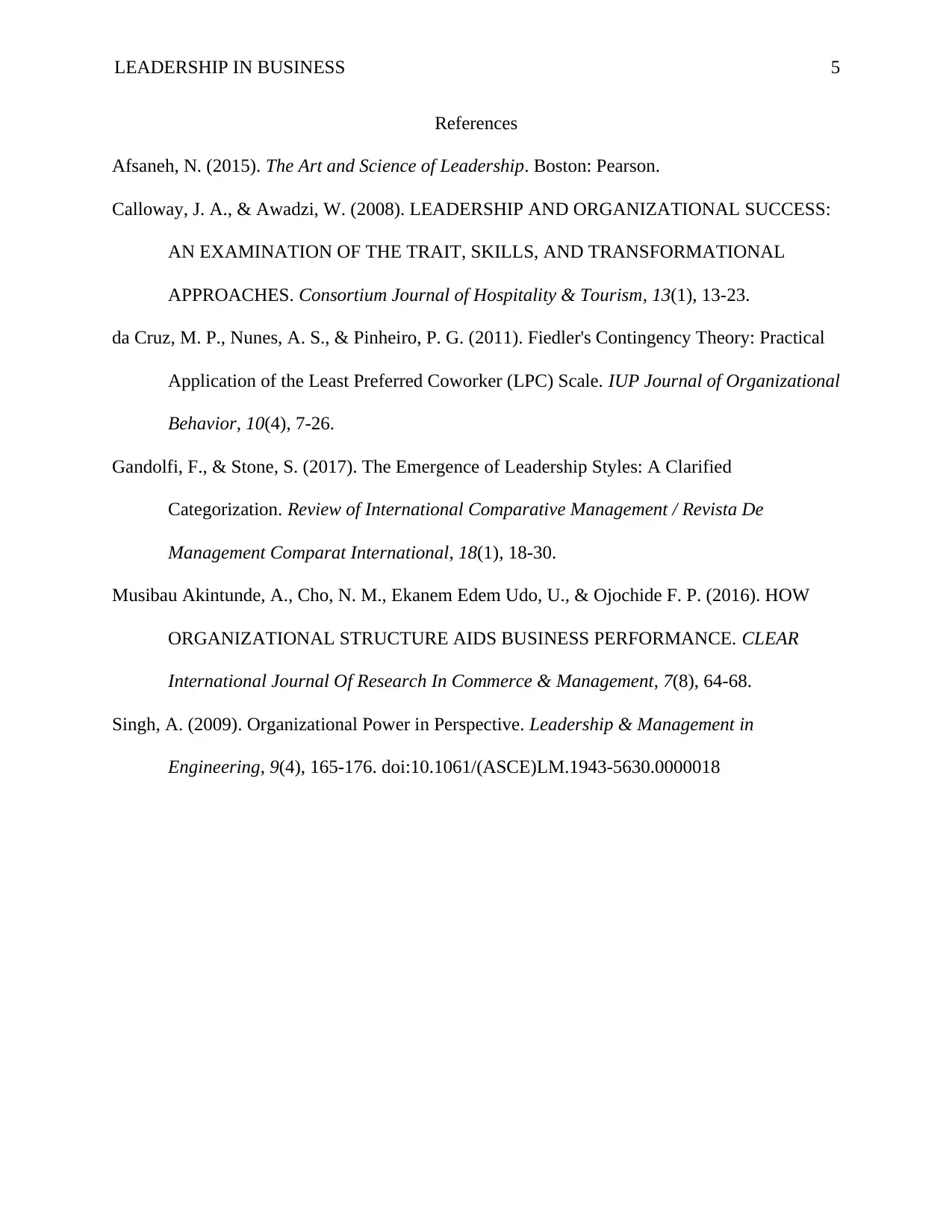
LEADERSHIP IN BUSINESS 5
References
Afsaneh, N. (2015). The Art and Science of Leadership. Boston: Pearson.
Calloway, J. A., & Awadzi, W. (2008). LEADERSHIP AND ORGANIZATIONAL SUCCESS:
AN EXAMINATION OF THE TRAIT, SKILLS, AND TRANSFORMATIONAL
APPROACHES. Consortium Journal of Hospitality & Tourism, 13(1), 13-23.
da Cruz, M. P., Nunes, A. S., & Pinheiro, P. G. (2011). Fiedler's Contingency Theory: Practical
Application of the Least Preferred Coworker (LPC) Scale. IUP Journal of Organizational
Behavior, 10(4), 7-26.
Gandolfi, F., & Stone, S. (2017). The Emergence of Leadership Styles: A Clarified
Categorization. Review of International Comparative Management / Revista De
Management Comparat International, 18(1), 18-30.
Musibau Akintunde, A., Cho, N. M., Ekanem Edem Udo, U., & Ojochide F. P. (2016). HOW
ORGANIZATIONAL STRUCTURE AIDS BUSINESS PERFORMANCE. CLEAR
International Journal Of Research In Commerce & Management, 7(8), 64-68.
Singh, A. (2009). Organizational Power in Perspective. Leadership & Management in
Engineering, 9(4), 165-176. doi:10.1061/(ASCE)LM.1943-5630.0000018
References
Afsaneh, N. (2015). The Art and Science of Leadership. Boston: Pearson.
Calloway, J. A., & Awadzi, W. (2008). LEADERSHIP AND ORGANIZATIONAL SUCCESS:
AN EXAMINATION OF THE TRAIT, SKILLS, AND TRANSFORMATIONAL
APPROACHES. Consortium Journal of Hospitality & Tourism, 13(1), 13-23.
da Cruz, M. P., Nunes, A. S., & Pinheiro, P. G. (2011). Fiedler's Contingency Theory: Practical
Application of the Least Preferred Coworker (LPC) Scale. IUP Journal of Organizational
Behavior, 10(4), 7-26.
Gandolfi, F., & Stone, S. (2017). The Emergence of Leadership Styles: A Clarified
Categorization. Review of International Comparative Management / Revista De
Management Comparat International, 18(1), 18-30.
Musibau Akintunde, A., Cho, N. M., Ekanem Edem Udo, U., & Ojochide F. P. (2016). HOW
ORGANIZATIONAL STRUCTURE AIDS BUSINESS PERFORMANCE. CLEAR
International Journal Of Research In Commerce & Management, 7(8), 64-68.
Singh, A. (2009). Organizational Power in Perspective. Leadership & Management in
Engineering, 9(4), 165-176. doi:10.1061/(ASCE)LM.1943-5630.0000018
1 out of 5
Related Documents
Your All-in-One AI-Powered Toolkit for Academic Success.
+13062052269
info@desklib.com
Available 24*7 on WhatsApp / Email
![[object Object]](/_next/static/media/star-bottom.7253800d.svg)
Unlock your academic potential
Copyright © 2020–2025 A2Z Services. All Rights Reserved. Developed and managed by ZUCOL.





